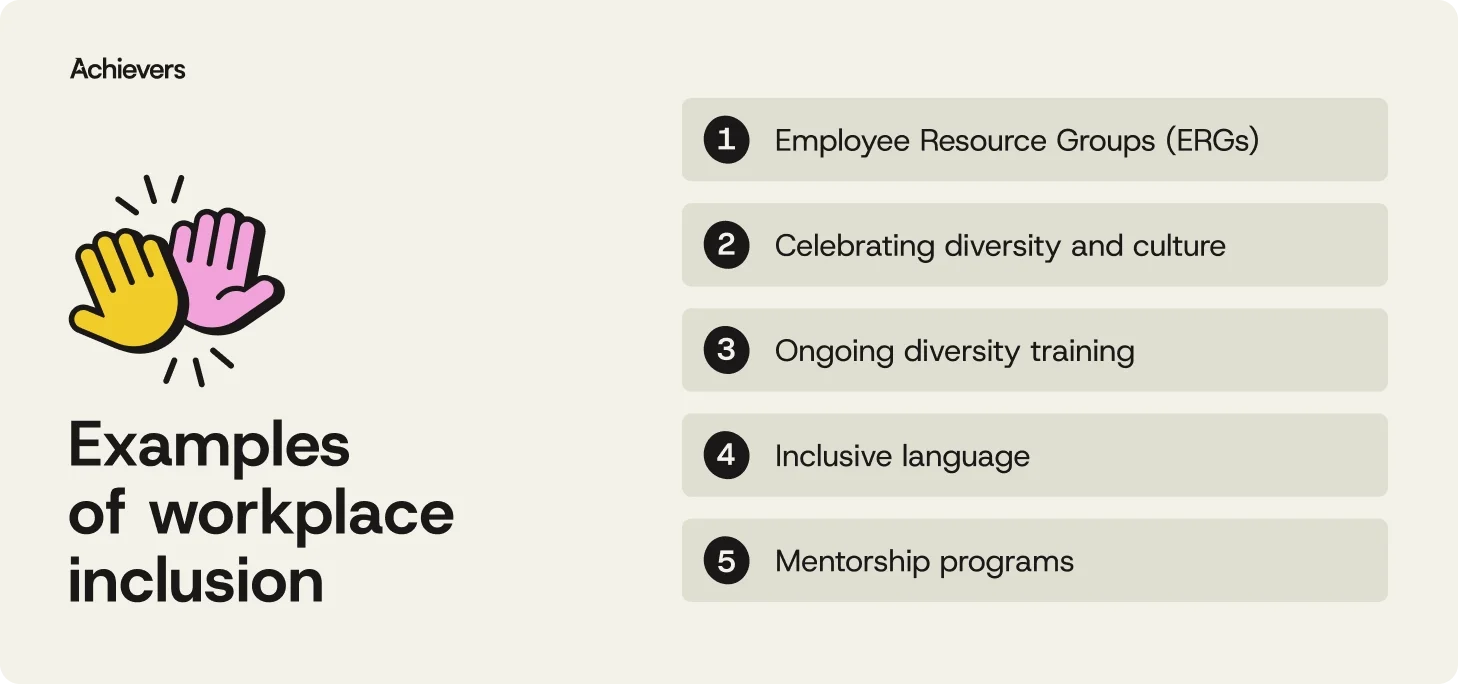Table of contents
Create a culture that means business™
Schedule a demo with an Achievers solution expert today.
Workplace inclusion isn’t just about making people feel welcome (though that matters, too). It’s about unlocking what happens when diverse voices are heard, respected, and empowered to lead. Companies that get it? They don’t just attract top talent — they outperform. According to Gallup’s State of the Global Workplace, inclusive environments can drive a 56% increase in performance and a 37% decrease in absenteeism.
That’s not just correlation — it’s cause and effect. Inclusion fuels creativity, psychological safety, and better decision-making across the board. And when it’s woven into the way your teams collaborate, grow, and recognize each other, the business impact speaks for itself.
So how do you move beyond good intentions and start making workplace inclusion a lived reality? It starts with understanding why it matters — and what it actually looks like in action.
Why is inclusion important in the workplace?
Inclusion isn’t a corporate slogan — it’s how you unlock the full potential of your people. When employees feel genuinely included, they’re more likely to contribute, collaborate, and stay engaged. That momentum drives stronger performance, higher retention, and a culture people actually want to be part of.
Here are a few essentials that help build a truly inclusive environment:
- Psychological safety: This is the foundation. When employees feel safe to ask questions, take risks, and share ideas without fear of judgment, real innovation can happen.
- Addressing microaggressions: Creating an inclusive culture means paying attention to the everyday moments — and calling out the subtle behaviors that can exclude or alienate.
- Sense of belonging: When people feel like they can show up as themselves — and be heard — they’re more likely to stay engaged, connected, and committed to their work.
Examples of inclusion in the workplace
Workplace inclusion shows up in the everyday — not just in policies, but in how people connect, communicate, and support each other. When employees feel seen, respected, and valued, they’re more likely to contribute their best work.
The good news? You don’t need to overhaul everything to start building an inclusive culture — but you do need to be intentional.

Here are six examples of how organizations put inclusion into action:
- Employee Resource Groups (ERGs): These employee-led groups create space for connection and community among people with shared experiences or identities — and provide valuable insight into what inclusion actually looks like on the ground.
- Celebrating diversity and culture: Recognizing cultural holidays, heritage months, and employee stories helps build mutual respect and reinforces that difference is something to be honored, not hidden.
- Ongoing diversity training: One-and-done training doesn’t cut it. Regular sessions that focus on equity, allyship, and cultural awareness help embed inclusive behavior into the everyday.
- Inclusive language: Language shapes culture. Encouraging inclusive communication — in meetings, materials, and everyday interactions — helps ensure everyone feels acknowledged and respected.
- Mentorship programs: Inclusive mentorship means creating access — across backgrounds, levels, and roles. Done well, it opens doors, builds confidence, and strengthens internal mobility for underrepresented talent.
- Valuing diverse perspectives: Inclusion in the workplace means listening — really listening — to the voices in the room. Make space for different viewpoints, amplify ideas that challenge the norm, and ensure all employees have influence, not just a seat at the table.
How to foster workplace inclusion
Inclusion doesn’t happen by accident. It takes everyday choices, structural support, and leadership that walks the talk. Without it, even the most well-intentioned DEIB strategies fall flat. But when inclusion is baked into how people lead, hire, communicate, and grow — the ripple effect is real.
Here are key ways to build a more inclusive workplace from the inside out:
- Inclusive leadership: It starts at the top. Leaders need to model inclusive behaviors — and back it up with action. That means embedding DEIB into decisions, priorities, and performance expectations.
- Inclusive hiring practices: Don’t just broaden your recruiting channels — look inward, too. Build diverse interview panels, standardize evaluations, and review job descriptions for bias. Inclusive hiring starts before a candidate even hits “apply.”
- DEIB-focused training: Awareness is a start — but action is the goal. Regular, practical training helps employees understand what inclusion looks like in real life and how to practice it daily.
- Open, safe communication: Inclusion thrives in environments where people can speak up without fear. Create space for honest conversations, feedback for managers, and overall open dialogue — especially around tough topics.
- Equal access to opportunity: Advancement shouldn’t depend on who gets tapped on the shoulder. Make sure systems and processes give all employees a fair shot at growth and development.
- Addressing unconscious bias: Bias can sneak into hiring, promotions, and day-to-day decisions. Proactively identifying and reducing bias helps level the playing field and support equity at every stage.
- Encouraging authenticity: When employees feel safe being themselves, they engage more deeply. Creating a culture that values authenticity signals that every voice matters — not just the loudest ones.
- Equitable access to resources: Inclusion goes beyond who’s hired — it’s about who gets the tools, mentorship, visibility, and support to grow. Whether it’s onboarding, upskilling, or leadership opportunities, make sure everyone has what they need to succeed — not just those who speak up the loudest.
Best practices for embedding workplace inclusion at scale
Inclusion shouldn’t be aspirational — it should be operational. It’s not just about what you say in an all-hands; it’s about how your culture shows up in the tools you use, the leaders you grow, and the behaviors you recognize.
Here’s how to build inclusion into the bones of your organization — and how Achievers helps make it real.
1. Build inclusion into manager enablement
Inclusion starts with the people leading the room. But most managers haven’t been taught how to create space for different voices, perspectives, or needs. That’s where structured enablement comes in.
With Achievers, you can equip managers with behavioral insights, in-the-flow nudges, and recognition data to help them build more inclusive, high-trust teams — no guesswork required.
2. Bake it into performance and promotion processes
If inclusion only lives in your values slide, it won’t shape how people grow. Real inclusion means tying it to advancement: in reviews, promotion criteria, and leadership development.
The Achievers platform lets you spotlight inclusive behaviors — and recognize them in the moment. That visibility helps turn values into measurable, promotable habits.
3. Make data your ally
You can’t fix what you can’t see. Inclusion needs insight — not just intent. From pulse feedback to recognition trends, organizations need clear signals about what’s working, where gaps exist, and how employees are experiencing culture in real time.
With the deepest recognition and engagement data set in the industry, Achievers helps organizations course-correct before disengagement sets in.
4. Close equity gaps in recognition and opportunity
Recognition should be for everyone — not just the people who speak up the most. With Achievers’ global, points-based platform, every employee can give and receive meaningful recognition tied to real behaviors — no matter their level, location, or role.
You also get the reporting to see who’s being recognized, who’s not, and what that says about opportunity across your organization. In fact, companies with high adoption of the Achievers platform see 5x the impact on engagement, productivity, and retention. That’s what happens when inclusion moves from principle to practice.
5. Keep inclusion visible — and evolving
Inclusion isn’t a one-and-done campaign. It’s a living, breathing part of culture — and it needs visibility to stay relevant. That’s where recognition plays a role again: not just as feedback, but as storytelling. Each moment of appreciation reinforces what good looks like.
With coverage in 190+ countries and 200+ languages, Achievers makes inclusion part of the everyday employee experience — from onboarding to milestones and everything in between.
Building inclusion starts with recognition
Inclusion takes more than good intentions — it takes systems that support equity, leaders who model it, and tools that recognize it in real time.
That’s where Achievers comes in.
Our employee recognition platform helps you make inclusion part of the everyday employee experience — with recognition, insights, and feedback tools built to surface diverse contributions, close equity gaps, and keep inclusion visible across your entire organization.
So if you’re ready to move beyond the checkbox — and build a culture where everyone feels like they belong — we’re here to help you shape that future.


